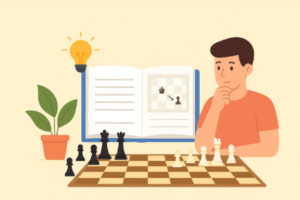How to study the opening in chess
♟️ How to Study Chess Openings Properly
Introduction
Many beginners dream of memorizing a few strong openings and instantly winning games.
But an opening is not just a sequence of moves — it’s the foundation on which the entire game is built.
A single mistake here can cost not only a piece but your whole strategy.
Let’s explore how to study openings wisely — to understand them, not just memorize them.

1. Don’t Memorize — Understand the Ideas
Many beginners make a common mistake — they try to memorize an opening move by move.
What really matters is understanding the purpose behind each move.
For example, in the Italian Game (1.e4 e5 2.Nf3 Nc6 3.Bc4), the goal isn’t just to “develop the bishop,”
but to control the center and target the weak f7 square.
Understanding the ideas helps you stay confident even when your opponent plays something “off-book.”
2. Start with Classical Openings
If you’re a beginner, don’t rush into complicated systems like the Najdorf or Grünfeld Defense.
Start with simple and logical openings that clearly show key principles:
- Italian Game
- Ruy Lopez
- Queen’s Gambit
- Slav Defense
These teach you to develop your pieces, control the center, and keep your king safe.
3. Study Typical Plans, Not Just Moves
Each opening leads to certain types of positions. For example:
- In the Sicilian Defense, Black counterattacks on the flank.
- In the Queen’s Gambit, White often builds pressure in the center and along the c-file.
📘 Tip: when studying any opening, take notes on typical plans, sacrifices, and weak squares.
4. Learn from Masters’ Games
The best way to understand an opening is to see how strong players handle it.
Watch 5–10 classic games and try to explain every move to yourself.
This helps you grasp the logic behind the opening rather than just its “formula.”
5. Practice and Analyze
After each game, ask yourself:
“Did my opening go well? Why or why not?”
If you ended up with a bad position, try to understand where you strayed from the plan.
Always analyze your games — first on your own, then with a coach or engine —
but only after you’ve made your own conclusions.
Conclusion
Studying openings isn’t about rote memory — it’s about developing strategic thinking.
Understanding key ideas, reviewing master games, and consistent practice
will make your openings solid and flexible.
Remember: chess games aren’t won in the opening,
but a good start is half the victory.